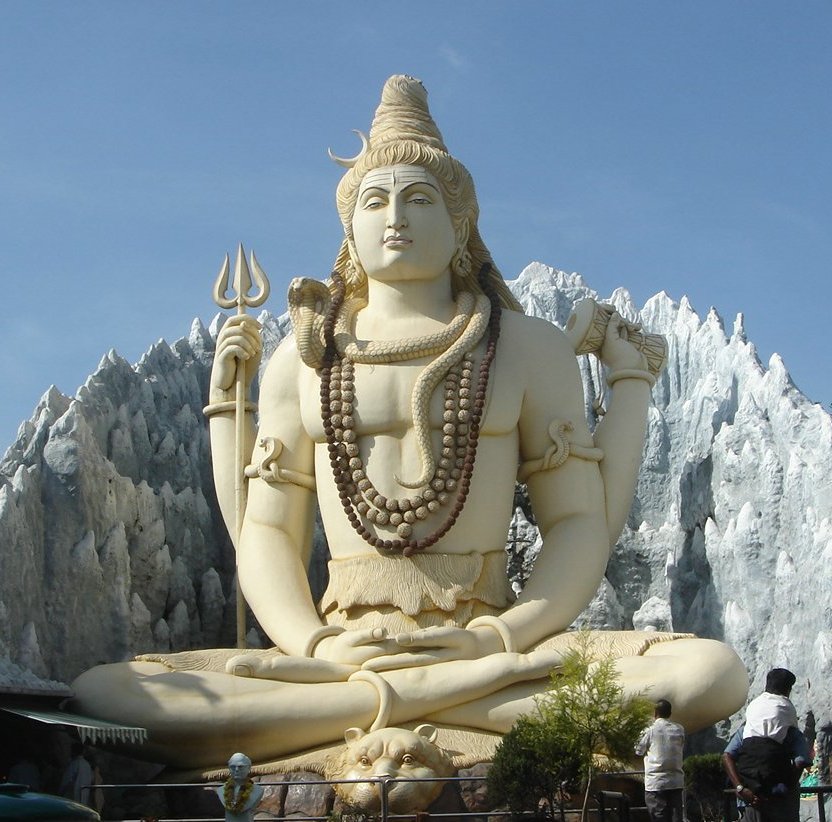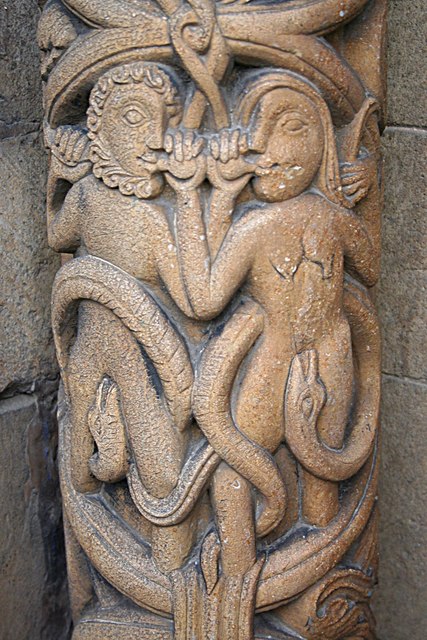 |
| Adam and Eve and the Serpent Image by Google Gemini |
The story of the Garden of Eden, chronicled in the book of Genesis, is arguably the West's most foundational narrative of humanity's origin.
It details a state of perfect unity (Eden), a moment of choice (the Forbidden Fruit), and the catastrophic consequence: a descent into duality, suffering, and mortality (the Fall).
While this story is read literally by billions, its profound allegorical depth finds startling parallels in the ancient Indian wisdom traditions, particularly those rooted in Yoga and Vedanta. The yogic journey, which maps humanity’s return to its divine source, provides an astonishing framework for interpreting the expulsion from Eden, suggesting that the “fall” is not merely a historical event but an archetypal description of the birth of the individual ego and the commencement of the spiritual journey.
The Biblical Narrative: A Loss of Unified Consciousness
The essence of the Adam and Eve story is the transition from a state of unconscious innocence to a state of conscious, judgmental experience. Before consuming the fruit from the Tree of the Knowledge of Good and Evil, Adam and Eve existed in a state of pre-duality, a condition described by the Bible as “naked and not ashamed.” They had no concept of ‘good’ versus ‘evil’ or ‘self’ versus ‘other.’ They were simply extensions of the Garden, living in perfect harmony with the divine source.
The serpent—often interpreted as the archetype of temptation, intellect, or primordial energy—introduces the decisive choice. 
Lord Shiva
in a Meditative Posture
Kalyan Kumar, CC BY-SA 2.0,
via Wikimedia Commons
The act of eating the fruit is the act of choosing empirical knowledge over intuitive unity. The immediate consequence is not just punishment but a shift in consciousness: "The eyes of both were opened, and they knew that they were naked."
This new awareness is the awareness of separation, judgment, and self-consciousness. It is the birth of the individualized ego, which instantly erects a barrier between the self and the divine presence.
The subsequent expulsion from Eden is the spiritual exile of humanity into the material world, burdened by toil, pain, and the relentless cycle of life and death. The sword-wielding Cherubim guarding the gate merely represent the difficulty in reversing this descent once duality has taken root.
 |
| Adam and Eve and the Serpent Image by Google Gemini |
Core Yogic Cosmology: Purusha, Prakriti, and Maya
To understand the connection, one must first grasp the foundational yogic view of reality, primarily articulated in Samkhya philosophy, which forms the basis for Yoga.
Purusha and Prakriti: Existence is defined by two eternal realities: Purusha (Pure Consciousness, the unmoving Seer) and Prakriti (Primal Matter, the dynamic, ever-changing material world). Eden can be seen as the state where Purusha (Adam/Eve's soul) was unconfused by Prakriti. The "fall" is the soul mistaking itself for its material vehicle.
Maya and Avidya (Illusion and Ignorance): The material world (Prakriti) is governed by Maya, the power of illusion that makes the temporary seem permanent and the separated seem whole. The state of Adam and Eve after the fall is the state of the soul suffering from Avidya, or fundamental spiritual ignorance—the ignorance of its true, unified nature. They became fully immersed in the illusion of time, effort, and separation.
The Gunas: Prakriti is composed of three qualities, or Gunas: Sattva (purity, light), Rajas (activity, passion, drive), and Tamas (inertia, darkness, resistance). Before the fruit, Adam and Eve resided in pure Sattva. The moment of choice, prompted by the serpent, is the introduction of Rajas (the impulse to act and strive for knowledge), which inevitably leads to the experience of Tamas (suffering and inertia). The Garden, therefore, is an allegory for a reality untouched by the fluctuation of the three Gunas.

Adam and Eve
Richard Croft / Adam & Eve
The Serpent Allegory: Kundalini and the Nadis

Richard Croft / Adam & Eve
The most striking allegorical link is the figure of the Serpent. In the West, it is predominantly seen as a symbol of evil; in the yogic tradition, it is viewed as the ultimate symbol of primordial energy and potential.
In Kundalini Yoga, the serpent represents the Shakti, or divine feminine energy (coiled power), that rests dormant at the base of the spine in the Muladhara Chakra. This coiled serpent, Kundalini, is the energy of consciousness waiting to be awakened.
The spiritual journey (sadhana) of the yogi is the systematic process of awakening this serpent and guiding it upward through the central energy channel, the Sushumna Nadi, to reunite with pure consciousness (Purusha) at the crown of the head (Sahasrara chakra).
The Yogic Interpretation of the Fall:
The Tree of Knowledge: This is the human body itself, which hosts the elaborate network of Nadis (subtle energy channels).
The Serpent’s Temptation: The temptation is the activation of the subtle energy system, but in a fractured, downward-directed way. The fruit represents the powerful knowledge that splits unitary energy into dualities.
Adam and Eve (Ida and Pingala): In yogic anatomy, the main central channel (Sushumna) is flanked by two channels: Ida (the lunar, feminine, cool, receptive energy—Eve) and Pingala (the solar, masculine, hot, active energy—Adam). Before the fall, the energy flowed harmoniously through Sushumna (the central path of unity/Eden). The serpent's influence is the moment the energy is diverted into the dualistic channels of Ida and Pingala. The individual consciousness becomes polarized (male/female, light/dark, good/evil) and trapped in the material world.
The Descent: The fall from Eden is the descent of consciousness from the higher chakras (associated with divine and universal consciousness) down to the lower chakras (associated with survival, sexuality, and ego), where the serpent (Kundalini) remains trapped, only to be rediscovered and raised consciously by the yogi seeking Moksha.
The Path Back to Eden: The Necessity of Yoga
If the Adam and Eve story is the myth of the descent, then the entirety of the yogic path is the methodology for the ascent. The goal of Yoga is Samadhi—a state of ecstatic union—which is the spiritual equivalent of re-entering the Garden of Eden.
The yogic journey reverses the consequences of the forbidden fruit:
Biblical Consequence (The Fall) | Yogic Practice (The Ascent) |
|---|---|
Separation/Duality (Good/Evil, Self/Other) | Pranayama & Asana: Balancing Ida and Pingala (Adam and Eve) to stabilize the body and mind, preparatory to unifying the dualities. |
Ignorance (Avidya) (Not knowing their true nature) | Jnana Yoga: The path of knowledge/wisdom to distinguish Purusha from Prakriti, leading to self-realization. |
Toil/Suffering (Samsara) (Birth pangs, struggle to survive) | Karma Yoga: The practice of selfless action without attachment to results, freeing the individual from the binding effects of karma (toil). |
Ego (Ahamkara) (Self-consciousness, shame) | Bhakti Yoga: The path of devotion, surrendering the individual ego to the Universal Divine. |
The key takeaway is that the “knowledge” gained from the fruit, while seemingly a curse that introduced suffering, is also the essential prerequisite for the spiritual journey. One must first become aware of duality and separation (the fruit’s effect) before one can consciously strive for unity (the yogi’s goal).
 |
| Lord Shiva in a Meditative Posture Kalyan Kumar, CC BY-SA 2.0, via Wikimedia Commons |
The yogi’s path of Tapas (austere spiritual practice), meditation, and ethical living is the manual for scaling the Cherubim-guarded gates.
By raising the coiled energy (Kundalini) back up the central channel (Sushumna), the yogi systematically dismantles the illusion of the material world and dissolves the individualized ego (Ahamkara), eventually returning to the state of non-dual consciousness—a state which, regardless of whether you call it Moksha or Eden, represents the ultimate human liberation.
The enduring resonance of the Adam and Eve story, when viewed through the profound lens of yogic teachings, transforms it from a tale of simple disobedience into a universal blueprint for the human condition—a magnificent spiritual allegory that maps the soul’s journey from unity, through separation, and finally back to transcendent wholeness.